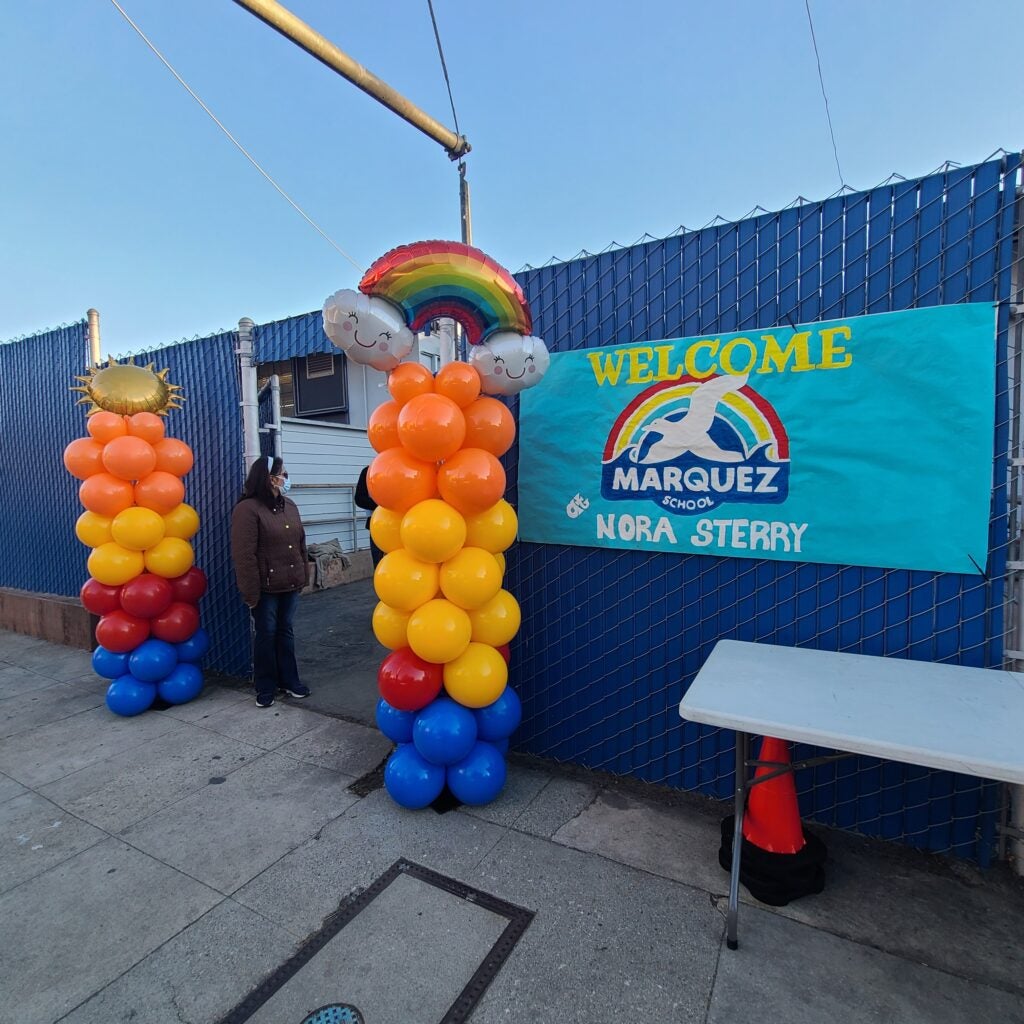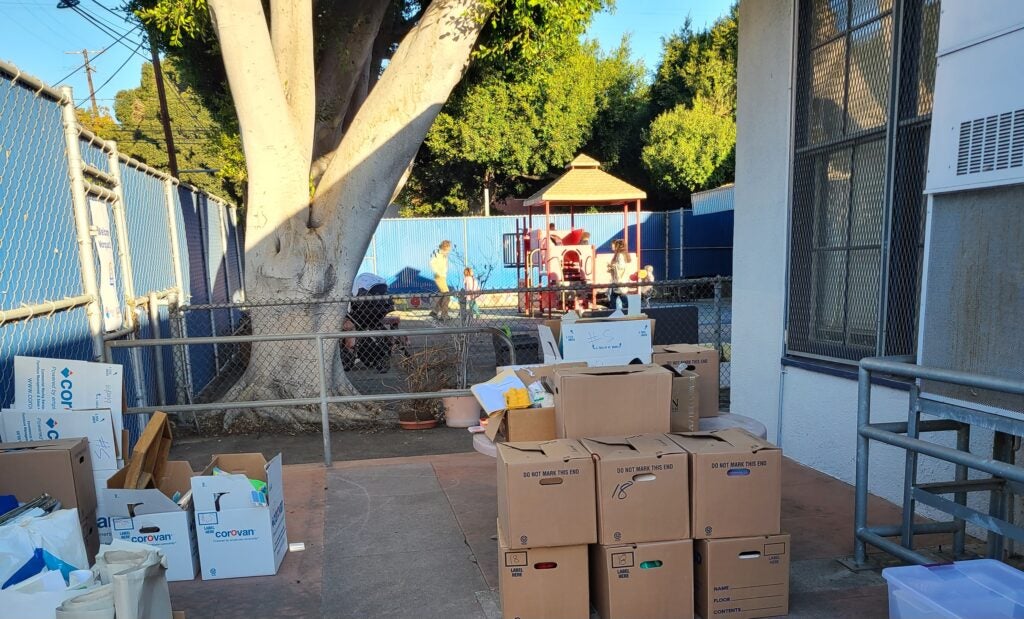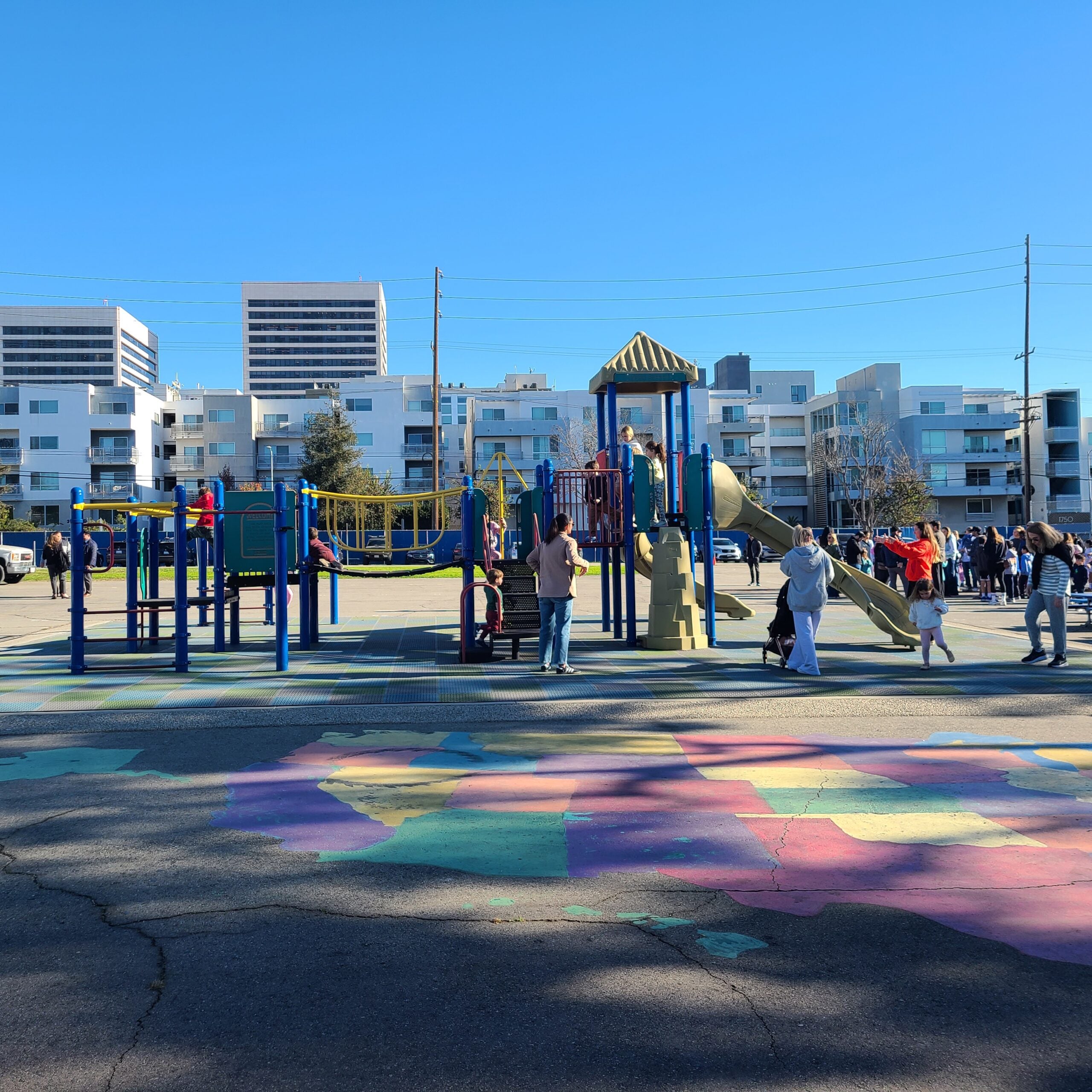Sarah Bang, Director, P-12 Public School Partnerships at UCLA School of Education and Information Studies reflects on K-12 educational needs after the LA Wildfires while spending time at Nora Sterry Elementary School.
While fires continued burning, and it felt like the entire city was suspended in a collective breath, schools were preparing to host displaced students. Displaced students from schools that had burnt down, and schools located in evacuation zones, were directed to various host schools around Los Angeles. As a native Angeleno, I’ve never experienced a disaster of this magnitude. The devastation is overwhelming, yet amidst the chaos, the resilience and solidarity within the educational community continues.
The UCLA School of Education and Information Studies (Ed&IS) has a long history of collaboration and partnership with Nora Sterry Elementary, one of the host schools currently accommodating students from Marquez Charter Elementary, which was destroyed in the Palisades fire. Our teacher education program has placed student teachers there, hundreds of UCLA employees’ children have attended this school through the Tie-Ins program, and tens of thousands of volunteer hours have been served at this site by our UCLA community. In my role supporting public school partnerships, I was able to volunteer and be at the school site.

In the first days, the challenges presented seemed insurmountable. Most of the Nora Sterry teachers moved out of their classrooms and into different classrooms so that Marquez students could all be housed in the same area. Los Angeles Unified School District (LAUSD) crisis response quickly supplied new books, supplies and technology for Marquez students and teachers. There were also LAUSD teams of support on site such as the Tech Unit, Facilities, Mental Health, and movers to help with the immense jobs of packing up classrooms, moving boxes and furniture. Substitute teachers were on hand to cover Nora Sterry classrooms so teachers could continue with packing and setting up their classrooms. At times, these challenges felt overwhelming. Figuring out where things could be stored or staged felt like a monumental task.
The emotional energy was palpable, matched only by LAUSD’s immense response. As days passed, I found myself listening and observing, taking in the unfolding situation around me. The staff from both schools have been very supportive of one another despite the immense stress they are under. I witnessed lots of hugs, words of comfort exchanged and some tears. The raw emotion and courage I saw and experienced is both inspiring and heart breaking.
The needs of this school, and others like it, are not immediately apparent. When I asked about future support, there were no clear answers. It dawned on me that in times of crisis, immediate needs are fluid and not easily defined. The singular focus for all involved was to prepare classrooms to welcome children—to offer a sense of normalcy and stability during times of uncertainty.

With this realization, I shifted my approach. Instead of asking what they needed, I assured them that UCLA, the School of Education and Information Studies, and the entire Bruin community stand ready to support them as needs arise. This crisis demands long-term commitment–not just for the immediate aftermath, but for the ongoing healing and recovery for students, teachers, and the community.
Impacts at Schools Due to the Los Angeles Wildfires
- Extreme Disruption in Routine
- Thousands of displaced students in LAUSD are adjusting to new schools and environments
- Host schools are experiencing abrupt changes to their routines and operations as they accommodate displaced students
- Emotional Trauma
- Students and staff are witnessing and experiencing destruction on an unprecedented scale
- Children overhear parents’ reactions at home, compounding their anxiety and sense of insecurity
- Adults, including teachers and staff, face extreme stress due to loss of homes and stability, increasing risks of depression and anxiety
- Learning Loss and Widening Achievement Gaps
- Significant disruptions in learning may widen achievement gaps, particularly in underserved communities
- Temporary relocations and school closures have delayed instruction for thousands of students, further exacerbating educational inequities
- Adaptation Fatigue
- Schools are still recovering from the long-term effects of the pandemic, leaving students, families, and staff struggling to adapt to yet another major disruption
- Equity Concerns
- Potential for achievement gap to widen further, especially for less-resourced communities
- Co-located schools with differing demographics (e.g., Title I vs. non-Title I) may experience tensions due to disparities in resources and support
- Climate Anxiety/Eco-anxiety
- Children’s awareness of extreme weather events contributes to heightened eco-anxiety and feelings of helplessness about climate change
- The loss of outdoor education spaces, such as nature centers used for field trips, further limits opportunities for environmental learning and healing
- Additional Strain on Staff
- Many educators are dealing with personal losses, including homes destroyed by the fires, while still supporting students through the crisis
- Increased workloads and emotional stress can lead to higher risks of burnout, anxiety, and depression among staff members
These impacts highlight the urgent need for long-term support for schools, students, and educators as they recover from the devastation caused by the wildfires.
How Institutions of Higher Education (IHEs) Can Help Schools Affected by Wildfires
Long-Term Commitment
- Establish ongoing support programs
- Recognize that needs evolve over time
- Continue assistance beyond initial crisis period
- Focus on underserved communities
- Prioritize schools with limited resources
- Address equity concerns in disaster recovery
- Assist with routine school operations
- Support daily activities (testing, events, etc.)
- Provide resources for non-disaster-related needs
In the aftermath of disasters, it’s crucial to recognize that school needs are fluid and often unpredictable. While initial responses typically bring an outpouring of donations and volunteers, this support tends to diminish over time. This decline can leave schools, particularly those serving lower-income communities, with dwindling resources. It’s important to remember that schools face significant demands even during normal academic years, including standardized testing, parent-teacher conferences, extracurricular activities, and school events. In times of crisis, these routine responsibilities don’t disappear; they become additional challenges atop disaster-related issues. Effective long-term support must therefore extend beyond immediate material needs like supplies, backpacks, books, and clothing. When possible, it should encompass assistance with day-to-day operations and regular school functions.
Leveraging Existing Resources and Relationships
- Utilize established university programs
- Engage departments with existing school partnerships
- Tap into student groups for volunteer efforts
- Collaborate with specialized programs
- Partner with initiatives like UniCamp for community building
- Offer supervised activities for schools hosting displaced students
IHEs like UCLA can leverage their educational and medical resources to support local schools affected by the wildfires. One effective approach is to engage department work and student organizations that already have established relationships with schools, utilizing their knowledge of school schedules, district guidelines, and campus layouts. Additionally, IHEs can look to specialized programs that already exist on campus such as UCLA UniCamp, which trains volunteers in community building and working with small groups of students. These volunteers can offer supervised activities for co-located schools, fostering new friendships between students from host schools and displaced schools.
Coordinating with School Districts
- Align with district initiatives
- Contribute to existing and newly created district programs
- Co-develop new efforts based on district needs
- Offer targeted resources
- Provide specific, actionable support
- Ensure resources are easily integrated into schools
It is also crucial for IHEs to align their resources with district initiatives by contributing to existing efforts and co-developing new ones based on specific district needs. Rather than imposing pre-designed solutions, IHEs can take the lead from districts and ask the district where to direct their resources most effectively. Providing targeted, actionable support is essential; this means avoiding vague or overly specific resources and ensuring that proposed programs are feasible within school constraints, such as space, time, and personnel availability.
Building Sustainable Partnerships
- Foster personal connections
- Develop long-term relationships with school staff and district-level personnel
- Maintain consistent communication
- Address institutional barriers
- Work to overcome bureaucratic challenges
- Align university and school district processes
To create lasting impact, it’s essential to approach partnerships between institutions of higher education and K–12 schools from a human-centered perspective. There are numerous barriers that often hinder P-20 collaboration (Jarsky et al., 2009). Building strong relationships is key to overcoming these barriers (Bang, 2020). Consistent communication and contact are crucial for rapid learning and effective problem solving. Breaking down bureaucratic barriers and silos is vital for maximizing potential. This includes addressing and understanding issues such as misaligned schedules between universities and school districts and navigating complex liability concerns. Success requires committed individuals from both organizations who are willing to bridge these gaps and turn well-intentioned ideas into actionable plans. By fostering human connections, maintaining open lines of communication, and offering relevant support, we can create more resilient and effective partnerships that truly serve the needs of schools and communities in times of crisis.
Professional Development and Support
- Provide training for educators
- Crisis management and resilience
- Conflict resolution and de-escalation
- Address ongoing mental health needs
- Support staff well-being and stress management
- Offer resources for trauma-informed teaching
It is important to recognize the growing demands placed on teachers, administrators, and staff. Providing targeted training and support is crucial to help these educators navigate both the challenges of disaster recovery and the evolving landscape of education. Teachers, administrators, and staff require ongoing training and support to meet growing demands and expectations. In particular, schools under continued stress would benefit from de-escalation strategies and conflict resolution training. Rogers (2024) highlights the impact of culturally divisive conflicts in schools and the additional fear, stress, and anxiety that it creates.
Collaborative and Informed Approach
- Learn from past disasters
- Study recovery efforts from events like Hurricane Katrina and Maui wildfires
- Adapt successful strategies to current context
- Partner with environmental education initiatives
- Support climate education programs
- Prepare P–20 educators to help students understand and cope with environmental changes
By examining responses to previous natural disasters like Hurricane Katrina and the Maui wildfires, educational institutions can develop more effective recovery strategies. Seeking assistance from national organizations and federal agencies like the U.S. Department of Education’s Readiness and Emergency Management for Schools (REMS) Technical Assistance Center can provide additional resources and guidance for comprehensive disaster response. Environmental education plays a critical role in helping students understand and process climate-related disasters. Organizations like EcoRise, UCLA’s Heat Lab, and UC/CSU ECCLPs offer valuable insight and experience in this field specifically within K–12 education. IHEs can play a crucial role in preparing educators with tools and resources for helping students cope with eco-anxiety and the mental health impacts of extreme weather events. By integrating these educational approaches, schools can transform potential trauma into opportunities for learning, resilience, and environmental stewardship.
Rebuilding our schools after this disaster demands more than physical reconstruction—it requires a multi-pronged approach that addresses emotional, educational, and systemic needs. Institutions of Higher Education, community organizations, and local districts must work together to create sustainable, adaptive support systems. By prioritizing mental health, maintaining flexible resources, and centering the experiences of students and educators, we can transform this crisis into an opportunity for meaningful, long-term educational innovation.
